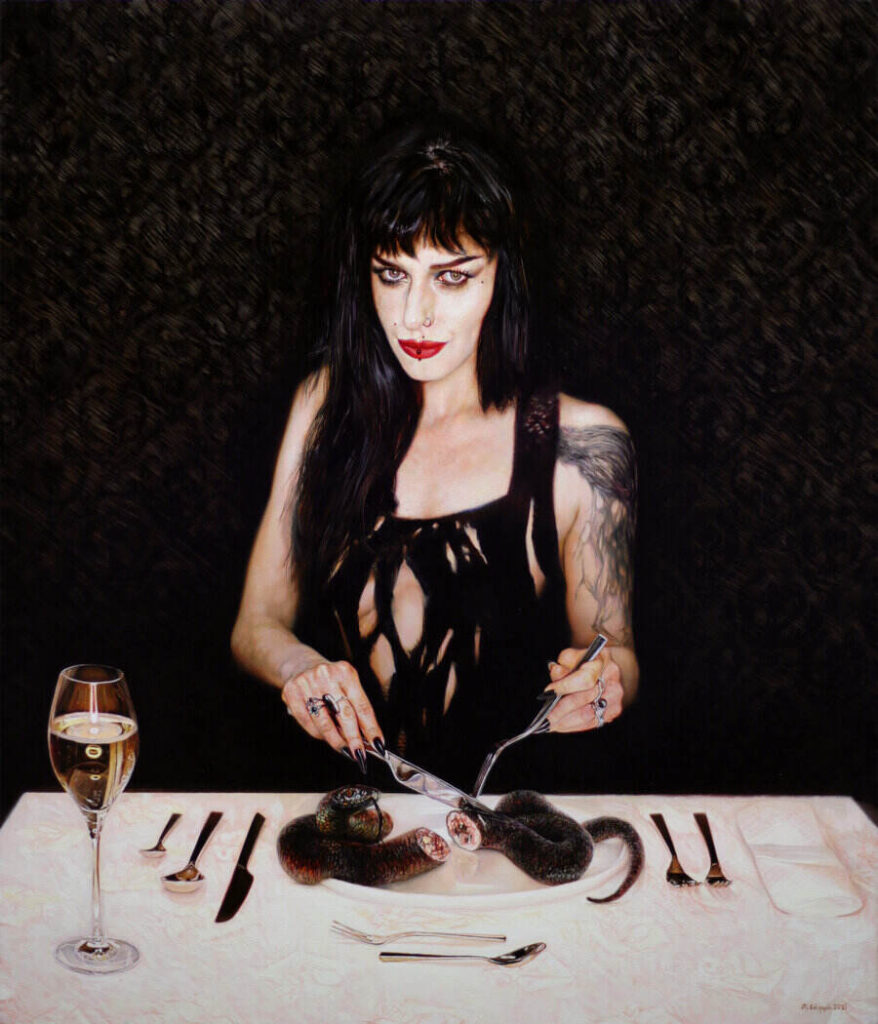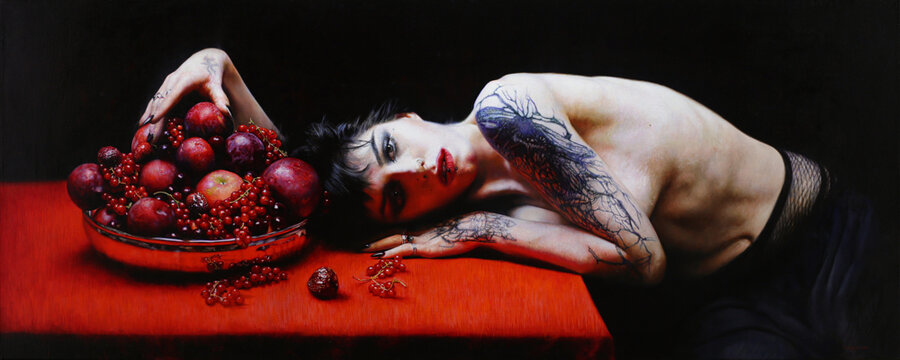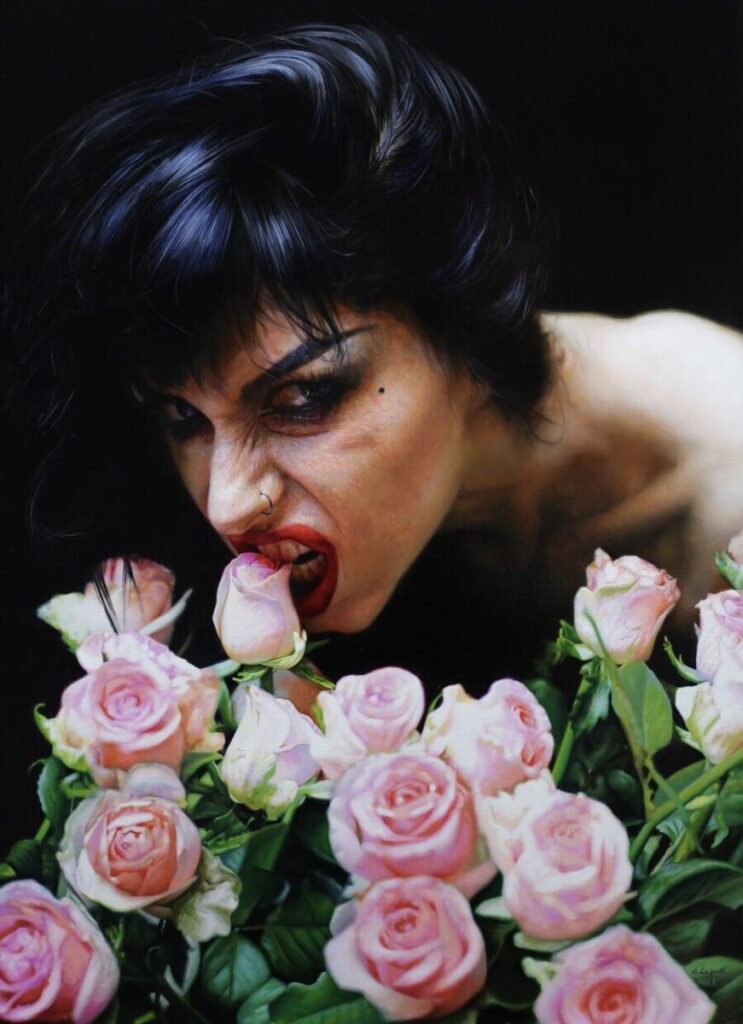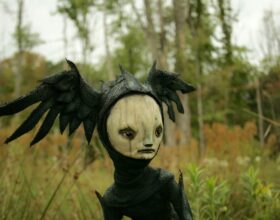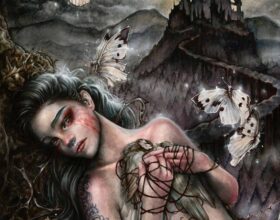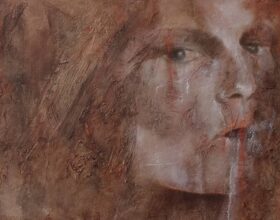Food is not only a necessity for physical survival, but daily meals are crucial in the construction of society, culture, and the people within. We are what we eat. Food and femininity are closely connected to women’s public perception and often strongly impact their emotional and physical integrity. We are seen as nurturing mothers and conscious consumers, expected to keep an eye on our personal health while facing the pressure to manage our body weight according to expectations from society and media. It is no wonder that the discourse on food and the power imbalance within constructs facets of our identity and directs the experience of eating on a daily basis.
Acknowledging these social circumstances, painter Anna Wypych has dedicated a whole series to the concept of ‘The Feast’. With four paintings, the artist showcases women eating and explores female representation through the lens of food. Anna, passionate about philosophy and the meanings behind the surface of our daily lives, loves to explore topics that might seem odd and strange to some, but ultimately dissect human existence and question the circumstances we take for granted.
As someone once told me, my paintings are strange portraits of women. But honestly, these paintings are portraits of thoughts.
During my interview with Anna, I was intrigued by her thought-provoking statements and the philosophical and critical context of the series ‘The Feast’. The connection between food, femininity and freedom, and how the artist highlights different aspects of this power triangle in her paintings impacted my perception of eating significantly – I am sure that you will feel the same!
Exclusive Interview with Anna Wypych
Could you introduce yourself and your art practice to the readers?
I am an artist who lives and works in Gdynia, Poland – mother and wife – I like to add this because the artist is not only composed of their art, but the private world influences and lives in what we create. In the past, I have often searched for female artists with a family to make sure that these things can be combined. I know that this information could be important for young female artists.
As someone once told me, my paintings are strange portraits of women. But honestly, these paintings are portraits of thoughts. I am an explorer, and I like to reflect on various topics that intrigue me at a particular moment. Each of my paintings has a story, and I often write short texts and even poems that complement the painting. But in general, two motives repeat in my every work – positivity. Even when I talk about difficult things like fear and sadness, the work’s ending, conclusion, and meaning are always positive. I prefer to share this energy with the viewer. With too many destructive emotions circulating globally, I want to add just a tiny positive perspective, no need for another terrifying story. Another theme that always comes back to me is like a boomerang. Inner strength and fortitude sometimes look almost like madness and allow each of us to do wonderful things once in a while. Yes, I believe that everyone holds this power!
I could be inspired by everything. I allow myself total freedom and the liberty to change.
What are the driving factors behind your creation? What inspires you?
(Anna laughs) It could be anything, literally, once I was inspired by a TV commercial. Over the years, I have watched the stages of being inspired by the most different impacts. Now I think it would be interesting to say how to have new ideas after several years of creating.
Inspiration is a state of mind in which you are open and “stupidly naïve” enough that ideas pop up in your head, and you can start to implement them. “Stupidly naïve” is especially important because it is very easy to fall into the spirals of higher and higher expectations and finally create nothing or something terribly “stiff”. But to answer your question, I could be inspired by everything. I allow myself total freedom and the liberty to change.
Sometimes I am inspired by old classic art, sometimes by just something from culture. Sometimes something from my everyday life, I then generalise so that everyone can see something in it. And sometimes, I observe a more fashionable or universal topic from all sides and look for an unusual perspective and context to interpret it innovatively.
I saw a similar theme of a woman eating in several other film productions. There is something adult about it, something primal and something very feminine.
Can you give some examples of themes you worked on in the past?
When I was trying to have a baby, and a few other difficult things appeared in my life, I painted ‘Be / Have’ 2015, reflecting on desires to “have”, different levels of resignation, and different levels of the struggle for it. At one point, I was hypnotised by the theme of “freedom”. Like an interesting pebble on a beach, I explored from each side in subsequent paintings exploring the topic in various contexts. For example, freedom and time, freedom and love, freedom and parenthood. This is how the ‘Boson’ series was created.
After graduating from the Academy of Fine Arts in Gdańsk, I debuted with large-scale multi-figure scenes, which evolved into multiplied characters in smaller paintings. Even today, this theme comes back to me from time to time. For example, in the paintings ‘She the fire’ and ‘That obvious truth, there are many of you…’ I focused on self-acceptance and the journey inside oneself. I also like to return to the theme of water and fire, and recently I discovered the mood of eroticism.
Let’s talk about your series ‘Feast’ – I am fascinated by the topic and was excited to see how somebody would highlight the social relevance and perception of eating as a female. Could you elaborate on the concept and background?
Some time ago, I was attracted to the theme of women who eat or women eating their meal. In one TV series, I don’t remember its name, there was a scene where a woman messed up with her family and her relationships with people she loved. At one point, she returns to an empty house and sees a cake on the table. This was a giant birthday cake for several people, but no one will eat it. No one will come to the party. So she gets ready, takes off her white blouse, and ties her hair. She prepares herself slowly and carefully, like a duel or a fight. And then she starts to eat, with her hands, gets dirty, she eats a bite like an animal. There is something primal and intriguing about this. I saw a similar theme of a woman eating in several other film productions. There is something adult about it, something primal and something very feminine.
In general, feeding, eating, having a meal, and the meanings of a meal and the process itself, are incredibly inspiring. And the feast is a celebration of this very theme.
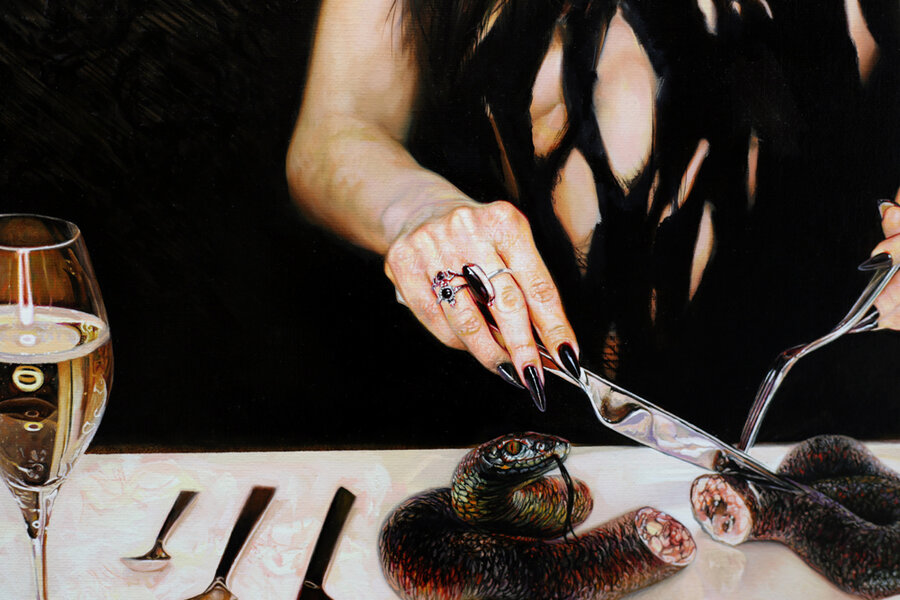

The series consists of four paintings – could you take us through them and share some thoughts about each?
‘Proper Meal – Snake’s Space’ initiates the series. It is the painting in which eating as an activity becomes a manifestation of power. My heroine is efficient, and her action is a bit like the male need to fight and dominate and confront but in female rules and version. Something is intriguing about the activity of eating, feeding, something feminine that is easy to miss, but it definitely exists. Is feeding the family, for example, not an act of domination over a territory? I don’t know, but there is definitely something primal about it. And a woman who eats freely can carry a lot of meanings – and I do not see them as negative. When you eat from someone – you trust, you submit. When you feed someone, you dominate in a way. When a free woman eats what she wants and how she wants, there is enormous power in it and a beautiful symbol. We could also explore the connection and meaning of the meal in many ways.
Is it possible to paint a naked woman next to a fruit platter so that it does not seem like an object, another dish?
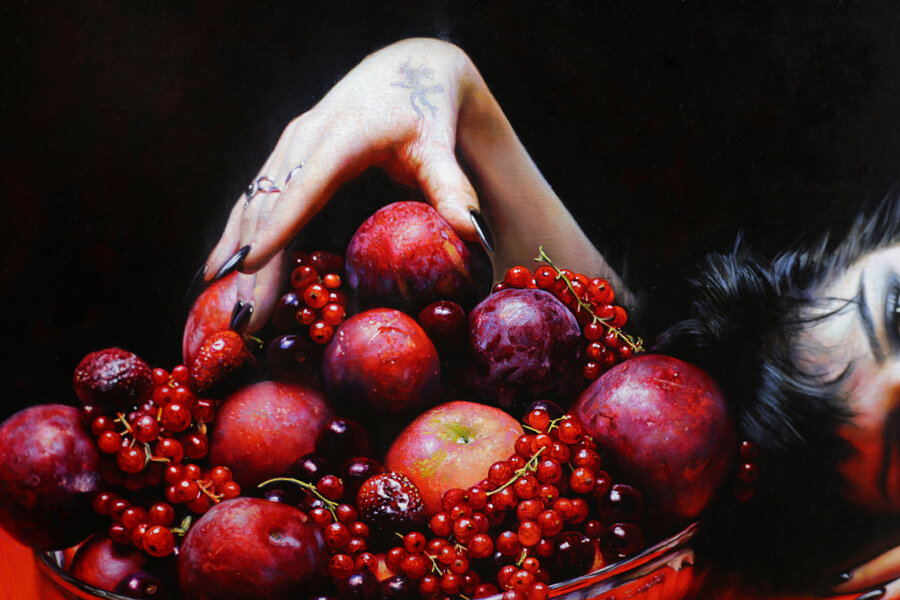

In ‘Playing with food’, I experiment with meanings and contexts. Because who and what is a meal here? Fruit on the plate? The woman next to them? Or maybe you, the viewer? Is it possible to paint a naked woman next to a fruit platter so that it does not seem like an object, another dish?
‘Nice’ is the next step of playing with stereotypes. Eating a bouquet of roses may be a symptom of madness or, on the contrary, a sign of self-awareness to defend one’s own boundaries. It could also symbolise freedom from “I have to be nice”, and you always have to thank me, even if the gift is actually a disguised act of aggression. In fact, flowers are not always flowers, and kind deeds are not always something genuinely lovely. Sometimes it seems that you receive care, but in reality, somebody aims to gain control. It looks like help but, in fact, takes your freedom piece by piece. Sometimes someone is feeding you, not to make you feel full, but to eat you fatter afterwards. Good things might not always be as good as they look. I encourage everybody to watch carefully what is happening around us and inside us, not only act like we are supposed to.

‘Insect – Lick Where It Hurts’, the last painting from the series, is a calmer ending so far. To tell the truth, I am not sure what I meant by it, but I knew it had to look exactly like this. An insect that stings and feeds on the subject was essential. She allows it, and she wants to lick the wound – or eat the insect? The uncertainty and the subtle erotic undertone of the painting evoke some energy.
We are causative, strong, and we know how to decide something and stand our ground for it. Nothing to be ashamed of, and if someone tries us, we will eat them.



The two main themes I always revolve around are positivity and inner strength. Freedom and independence in thinking are also important concepts for me, and they are often present in my work.
Femininity and food, let’s be critical! Why is it important to show women eating and not anybody else?
Behind this question hides the thinking that eating is something terrible, and embarrassing, but for me, it is not at all. Food can be read in many ways and can be an excellent metaphor for many aspects of life. When I look at my paintings in this way, I think that food can also be a metaphor for female aggression, which, after all, does not exist because we are supposed to be so kind, protective, and good by nature. Meanwhile, this aggression and bravery in us are just denied because it is considered so wrong and out of place for females; we are not meant to be aggressive and fight. Also, the expression is just different from the masculine version. We are causative, strong, and we know how to decide something and stand our ground for it. Nothing to be ashamed of, and if someone tries us, we will eat them. These are further considerations about power and strength, but only in our female edition. Let us be visible to ourselves. Let us see our anger and bravery!
What are you aiming to achieve through your art? What are the conversations and reactions you go for?
What are you creating for? This is one of the simplest and most difficult questions an artist can be asked. I have no mission or high message. I create because I have to because this is who I am, and this is how I perceive the world.
So what do I want to say? I always want to say something positive and give a little optimism, hope and self-confidence. Hence the two main themes I always revolve around are positivity and inner strength. Freedom and independence in thinking are also important concepts for me, and they are often present in my work.
Did you already plan some projects for the future? Would you want to share some ideas?
I like to diversify my work, and currently, I have several series of paintings waiting for me. At the moment, I am drawn to roses and fire, with a hint of eroticism. I’ve always avoided the latter but recently thought, why not – the future looks romantic and spicy!


